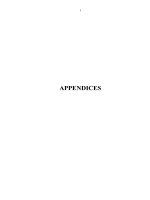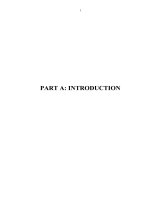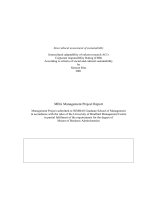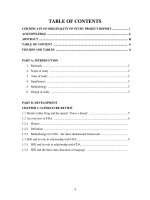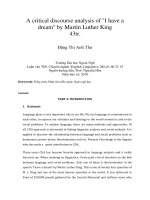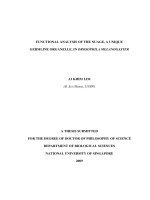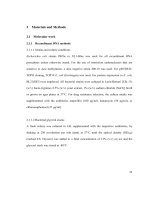A functional analysis of martin luther king’s speech “beyond vietnam a time to break silence”
Bạn đang xem bản rút gọn của tài liệu. Xem và tải ngay bản đầy đủ của tài liệu tại đây (1.14 MB, 84 trang )
MINISTRY OF EDUCATION AND TRAINING
QUY NHON UNIVERSITY
TRẦN THỊ TỐ NGA
A FUNCTIONAL ANALYSIS OF
MARTIN LUTHER KING‟S SPEECH
“BEYOND VIETNAM: A TIME TO BREAK SILENCE”
MASTER THESIS IN ENGLISH
Binh Dinh, 2020
BỘ GIÁO DỤC VÀ ĐÀO TẠO
TRƯỜNG ĐẠI HỌC QUY NHƠN
TRẦN THỊ TỐ NGA
PHÂN TÍCH BÀI PHÁT BIỂU
“BEYOND VIETNAM: A TIME TO BREAK SILENCE”
CỦA MARTIN LUTHER KING THEO NGỮ PHÁP CHỨC NĂNG
Chuyên ngành: Ngôn ngữ Anh
Mã số: 8 22 02 01
Người hướng dẫn: PGS.TS. Trần Văn Phước
i
STATEMENT OF AUTHORSHIP
Except where reference is made in the text of the thesis, this thesis
contains no material published elsewhere or extracted in the whole or part from
the thesis by which I have qualified for or been awarded another degree or
diploma.
No other person‟s work has been used without due acknowledgement in
the thesis.
This thesis has not been submitted for the award of any degree or diploma
in any tertiary institution.
Binh Dinh, 2020
Tran Thi To Nga
ii
ACKNOWLEDGEMENT
First and foremost, I would like to express my thanks to all the lectures
who have the given the foundation for this thesis and all the staff of the Postgraduate Department at Quy Nhon University for their encouragement, kindness
and administrative assistance.
My deepest gratitude and appreciation goes to my supervisor Trần Văn
Phước, Assoc. Prof. Dr. for his invaluable guidance.
My thanks are also due to I am immensely grateful to my aunt, Nhuan
Tri, for her help and kindness. Many, many thanks to all the teachers at Ton Duc
Thang High School in Duc Co District, Gia Lai Povince for creating the best
conditions to me.
I would like to take this opportunity to say thank you to my coworkers
and friends, whose kindness and support to my study were great.
I would like to show my sincerce thanks to many people who have given
me great help during the time I managed to complete this thesis.
Last but not least, I feel deeply indebted to my family, especially my
parents for always by my side whenever I got troubles.
iii
ABSTRACT
This Thesis entitled: A functional analysis of Martin Luther King‟s speech
“Beyond Vietnam: A Time to Break Silence” is conducted to aim at examing the
metafunctions of Martin Luther King‟s speech by analyzing its topic, content and
attitudes.
This
work
identified
the
Tenor/Interpersonal
metafunction,
Field/Experiential metafunction, Mode/ Textual metafunction and thematic
progressions were applied. In terms of Interpersonal metafunction, most of the
clauses are declarative, the main role of the speech is to declare the facts that
America‟s government neglecting their poverty program to interfere to Vietnam
war, which leads to the tragic consequences forward not only lives but resources
of both Vietnamese and American. In King‟s speech, the Modality becomes
prominent through a range of modal auxiliary verbs to indicate the necessity and
urgency of a protest against the war. From the Experiential metafunction
analysis, it can be concluded that the material processes dominate in six kinds of
processes. The central purpose of King is to mainly convey information about
the actions of breaking the rules and the cruel actios of America‟s government in
Vietnam. Morever, King mentions about the positive changes of life after
conducting a new revolution. Regarding to Textual metafunction, it helps
listeners to integrate in the King‟s messages. Topical theme accounts for the
highest percentage and multiple themes play a vital role to latch a sentence
explicitly on to the preceding context. Last but not least, is the analysis of
thematic progression, it is found that the speech also tends to employ the
constant theme pattern because it is easy for the speaker to develop the topic and
for the audience to be accepted. Thanks to thematic progression patterns the
related problems of ending Vietnam war are mentioned throughout the speech.
Hopefully, the reasearch is helpful to those whose are studying political
languages as well as learning how to make a successful speech.
iv
ABBREVIATIONS
King: Martin Luther King
E: Example
SFG: Systemic Functional Grammar
TH: Theme
RH: Rheme
1
CHAPTER 1: INTRODUCTION
1.1. Rationale of the study
Language is used as the most effective transportation not only to express
meanings but also carry out various functions in distinctive contexts and
situations of our lives. English has become an international laguage and the
second laguage of almost nations. Systemic Functional Grammar gradually tends
to the popular topics for reseachers and linguistists. If Syntax plays a vital role in
indicating the set of rules, principles, and processes that govern the structures of
the sentences in a particular language, Grammar is the sallient key in recognizing
the sounds of words, the meanings of those words and the different ways of
arranging words together to make meaningful sentences.The linguistic items are
investigated in various functional aspects synchronously because a linguistic unit
may have not only one function at a particular time.
It is a well- known fact that laguage is the main tool that human beings
use to communicate to each other, to express our attitudes and feelings to the
world around us such as in literatures, social problems, political aspects and so
on. According to Habermas (1992) stated, communication is an extremely
complex and ever- changing phenomenon. Communication allows humans not
only to express the shared set of physical, emotional, and psychological needs
that are alive inside us at any given moment, but also give this information to
others for enriching life for others and ourselves (Habermas, 1992).
However, only by using language, what the speaker‟s meaning can not be
understood thoroughly. Hearers have to combine it with its context and functions
for the apprehending of speaker‟s meaning. It is used for the interpretation of
hearer which hear the speaker, or reader which read the text. SFG can do this
because the way of this model of language explains the connection between
context and text for understanding the meaning of a language. In functional
2
linguistics, people can understand how the wording of the text simultaneously
encode three types of meaning: textual meaning, interpersonal meaning, and
ideational meaning, which are influenced by their context of situation: mode,
tenor, and field (Halliday, 1978, p.123).
From such a fact, to have deep insights into the nature and functions of
language analyzed by many methods and approaches, Functional Grammar has
attracted interest of not only many linguistists but also learners. A number of
studies were conducted and based on Functional Grammar. The social functions
language was emphasized by Halliday, the works of Schegloff, Jefferson and
Sack are important in the research of conversation, turn-taking and other aspects
of spoken interactions (Schegloff, Jefferson, & Sacks, 1977) .
Depending distinctive situations or contexts, language will have different
function forms, for example: stories, news, speech, poems, movies or songs. In
terms of speech, it an an aspect of language which is represented by the use of
signals produced by meant of human exhalation, phonation, articulation,
resonance, communicated by acoustic and auditory means (Milloy, 2013).
The writer has reasons of choosing speech as her object research which is
going to be analyzed. First, it is particularly true that language is the salient
method to communicate in our daily life. Especially, language seems to be a very
important tool used by political communities to establish group awareness and
cement voters by making them feel that their vote count. Therefore, Van Dijk
observed that each speech delivered by a politician is a realization of his
intention and has its own function (Van Dijk, 1997).
In addition to the powerful language, the speech also played on the
emotional story with a range of semiotic resources including the facial
expression, gestures, intonation and the impressive wait and pause before
speaking. Given that the speech has attracted so much attention and caused a
3
great sensation, it is worthwhile to take a closer look at it.
Furthermore, the reasons why the writer chooses Martin Luther
King‟s speech are, firstly, this speech is his most famous and influenced
speech among his seventeen speeches. In addition, it had influences not
only in America but Vietnam (the hometown of the writer) with title
“Beyond Vietnam: A Time to Break Silence”. He delivered it to oppose the
America‟s role in Vietnam war. King also criticized American opposition
to North Vietnam's land reforms in his speech.
Besides, Martin Luther King was a social activist and Baptist
minister who played a salient role in the American civil rights movement
from the mid-1950s until his assassination in 1968. Martin Luther King
was well-known of all time by his famous speeches which have fluency,
persuasives and the power to touch and charm million‟hearts.
“And if we will only make the right choice, we will be able to transform this
pending cosmic elegy into a creative psalm of peace.
If we will make the right choice, we will be able to transform the jangling
discords of our world into a beautiful symphony of brotherhood…”
He is best known for his role in advancement of civil rights using
nonviolent civil disobedience based on his Christian beliefs. In his entire
carrier as activist, he often got some precious awards, such as Nobel Peace
Prize for combating racial inequality through nonviolence. Last but not
least, he also awarded the Spingarn Medal from the National Association
for the Advancement of Colored People Martin Luther King had eleven
speeches before his tragic assassination.
[online] Available at:
/>ilence#Background [Accessed 8 October 2019]
In this thesis, I will follow systemic functional grammar (SFG) to
4
analyze the speech text. I determine to raise a research entitled: A
Functional Analysis of Martin Luther King‟s Speech “Beyond Vietnam: A
Time to Break Silence”.
1.2. Aims of the study
This study aims to identify the purposes or functions of Martin Luther
King‟s speech through their topic, content, and the attitudes realized by linguistic
features or lexico-grammatical realizations.
1.3. Objectives of the study
To achieve the aims above, the study will focus on objectives as follows:
(1) to identify the tenor of speeches (the attitudes) through the uses of
Mood structures and modality to express
interpersonal function/meaning
realized by their linguistic features;
(2) to identify the field of speeches (their content) through the uses of
processes to express experiential/ideational function/meaning realized by their
linguistic features;
(3) to identify the mode of speeches (their topics) through the uses of
thematic structures to express
textual function/meaning realized by their
linguistic features;
(4) to identify the communicative effectiveness of speeches through the
uses of thematic- progression patterns.
1.4. Research questions
In order to achieve the aims and objectives mentioned in this paper, I try
to find the answers to the following questions:
(1) What mood structures and modality and their lexico-grammatical
realizations are used to express the tenor or King‟s attitudes in speech?
(2) What transitivity structures and their lexico-grammatical realizations
are used to express the field of the Martin Luther King‟s speech?
5
(3) What thematic structures and their lexico-grammatical realizations are
are used to express the mode of Martin Luther King‟s speech?
(4) What types of thematic progression patterns are used to make Martin
Luther King‟s speech effective?
1.5. Scope of the study
Due to limited knowledge and time allocation, the study narrows the
functional analysis inspired by M.A.K. Halliday (1985, 1994, 2004) which was
revised by M.A.K. Halliday and Christian M.I.M. Matthiessen in 2004 (the third
edition) in some aspects of Field, Mode, Tenor and by Eggins (2004) in thematic
progression patterns developed by basing on Halliday‟s theory on the data of the
speech “Beyond Vietnam: A Time to Break Silence” of Martin Luther King.
Prosody or phonological aspects are beyond the analysis of the study.
1.6. Significance of the study
By investigating the values of Martin Luther King‟s speech “Beyond
Vietnam: A Time to Break Silence”. First of all, it will make a significant
contribution towards providing readers and learners with a thorough
understanding about language used in political speech in the light of functional
grammar. Morever, the result of this study is expected to give more information
both to teachers and learners about the utilization of political speech. It is hoped
to help users of English approach the political speeches in their language from a
different viewpoints, reconsider them in the light of functional grammar and use
them better in communication, language teaching and studying in political
speeches translation from English.
1.7. Organization of the thesis
The study consists of five chapters; each chapter takes responsibility for a
particular function.
Chapter I: Introduction
6
This chapter indicates the overview of the study consisting of statement of
the problem, research aims and objectives and research questions, the scope and
the structure of the study.
Chapter II: Literature review
In this chapter, all the terms as well as the key theoretical concepts of
functional grammar that the study is based on are clearly explicated so that the
following parts of the research can be easily followed by readers. Morever, it
reviews some previous studies of the issue which is investigated.
Chapter III: Research methodology
This chapter describes the methods and procedures to carry out the study.
It consists of the research design and procedures for doing this study, selection of
speech, the method of collecting data and data analysis.
Chapter IV: Findings and discussions
This chapter deals with the results of the study that the researcher
investigates from the collected data based on the research questions mentioned
above. It decribles the frequency, the lexico-grammatical realizations of each
feature in three metafunctions and thematic progression patterns.
Chapter V: Conclusion and Implication
A summary of the study, the major findings, the implications, the
limitations as well as suggestions for further studies are all mentioned in this
final chapter.
7
CHAPTER 2: LITERATURE REVIEW
In this research, the writer uses SFG was introduced and developed
originally by Michael Alexander Kirkwood Halliday, known as Halliday
(1978, 1985, 1994). The writer focuses on Halliday and Matthiessen (2004)‟s
theory about three metafunctions which include Interpersonal function and
Experiential function and Textual function. Beside, the writer also uses
Suzanne Enggins (2004) for analyzing the thematic progression patterns.
2.1. Review of previous studies related to the research
So far, there have been some studies on English political speeches.
Nguyễn Thị Thanh (2011) applied Systemic Functional Grammar in
order to investigate the structure in the speech “I have a dream” by Martin
Luther King (T. T. Nguyen, 2011).
Reza Fahlevi (2015) studied metafunction and context of situation
realized in Martin Luther King‟s speech “I have a dream”. The writer used
theories of Halliday (1985), Gerrot and Wignell (1994), and Enggins (2004)
to analyze metafunction and related it into context of situation realized
through register variable (Fahlevi, 2015).
Ubong E. Josiah and Gift Oghenerho (2015) analyzed the pragmatic
contents and sentence structures of the speech “I have a dream” by using the
speech acts theory, examined how the speaker made effective use of the speech
to advocate for equality and address racism, also identified the socio-economic
and political ideology inherent in the speech (Josiah & Oghenerho, 2015).
All those works do more or less to contribute to study political
speeches either in their structures, metafunction and context, pragmatics. In
general, until now there was no research on using SFG to analyze the speech
“Beyond Vietnam: A Time to Break Silence”.
8
2.2. Theoretical background
2.2.1. Definition of Speech and Text
Speech refers to the faculty or power of speaking; oral communication;
ability to express one's thoughts and emotions by speech sounds and gesture.
Traditionally, a text is understood to be a piece of written or spoken material
in its primary form (as opposed to a paraphrase or summary). A text is any
stretch of language that can be understood in context. It may be as simple as
1-2 words (such as a stop sign) or as complex as a novel. Any sequence
of sentences that belong together can be considered a text.
For Halliday and Hasan (1976, p. 1-2), the notion „text‟ is:
“[A term] used in linguistics to refer to any passage, spoken or
written, of whatever length, that does form a unified whole [….] A
text is a unit of language in use. It is not a grammatical unit, like a
clause or a sentence; and it is not defined by its size [….] A text is
best regarded as a SEMANTIC unit; a unit not of form but of
meaning” (Halliday & Hasan, 1976).
Functional linguists analyze a text, spoken or written, from a
functional point of view. A text is “a harmonious collection of meaning
appropriate to its context” (Butt & 2000) . To have thoroughly
understanding about a text is often impossible without reference to the
context where it begins. And context can be analyzed from two
perspectives: the context of culture and the context of situation. The
former refers to the broad sociocultural environment, which includes
ideology, social conventions and institutions; the latter relates to the
specific situations within the sociocultural environment (Droga & Humphrey,
2002).
2.2.2. Systemic Functional Grammar
Functional approach to grammatical analysis has been adopted over three
9
decades because of being a general theory concerning the grammatical
organization of natural languages. Halliday is well-known by his grammatical
theory and descriptions, outlined in his book entitled: An Introduction to
Functional Grammar, which was first published in 1985. A revised edition was
published in 1994, and then a third, in which he collaborated with Christian
Matthiessen, in 2004.
Systemic Functional Grammar (SFG), developed by Halliday and his
colleagues, has had a great impact on language learning and teaching. It is
different from all the previous models of grammar in that it interprets language
as interrelated sets of options for making meaning and seeks to provide a clear
relationship between functions and grammatical systems. Halliday (1994)
distinguishes three layers-called metafunctions-of meaning in language: the
ideational/ experiential, concerned with the resources to construe human
experience and realized by the system of transitivity; the interpersonal,
concerned with the resources available to speakers to interact with one another
(and thus make requests, offers, statements and questions) and realized by the
system of mood and modality; and the textual; concerned with the resources to
construct text and mainly realized by the system of theme (Halliday &
Matthiessen, 2004).
2.2.3. Three Metafunctions
These three aspects reflect the three main functions, or metafunctions, of
language. Halliday (1994) describes the three metafunctions as follows:
The ideational/experiential metafunction: It enables people to use language
to represent experience, and is influenced by field.
The interpersonal metafunction: It enables people to use language to enact
social relationships, and is influenced by tenor.
The textual metafunction: It enables people to use language to construct
logical and coherent texts, and is influenced by mode (Halliday, 1994).
10
2.2.3.1. Interpersonal meaning of the text.
Interpersonal meaning of the text can be analyzed by
interpersonal function which is realized by mood an d modality.
The
interpersonal
metafunction
is
about
the
social
world,
especially the relationship between speaker and hearer, and is
concerned with clauses as exchanges. It also is concerned with
language as a form of interaction between people, in order t o
“show how defensible or binding we find out prop osition or
proposal” (Butt, 2000).
The
system
of
mood
belongs
to
the
interpersonal
metafunction of the language and is the grammatical resource for
realizing an interactive move in dialogue (Martin, Matthiessen, &
Painter, 1997).
According to Halliday (1994, p.68), it is through the
interpersonal metafunction that people establish, negotiate and
assume their position in social relationship, and it is concerned
with clauses as exchange. The interpersonal meaning begins with
defining basic speech role: giving information, giving goods -andservices and demanding goods-and-services, respectively called
statement, questions and commands.
The two variables of speech role (giving and demanding),
and the variables of commodity (informati on and goods and
services), when taken together, define the four basic speech
functions: giving information, demanding information, giving
goods-and-services and demanding goods-and-services. The usual
labels for these functions are: statement, question, o ffer, and
command.
Figure
2.1
shows
these
options,
with
examples
11
illustrated:
Role in
Commodity exchanged
exchange
(a) goods-&-
(b) information
services
(i) giving
(ii)
demanding
„Offer‟
„statement‟
would you like this teapot?
he‟s giving her the teapot.
„command‟
„question‟
give me that teapot!
what is he giving her?
Figure 2. 1: Giving or demanding, goods-&- services or information
These basic functions are closely associated with particular grammatical
structures:
statements are most naturally expressed by declarative clauses,
questions by interrogative clauses, commands by imperative clauses, which are
the three main choices in the Mood system of the clause.
According to Halliday and Matthiessen (2004, p.72), every free clause
selects for Mood. Some, such as John! And Good night!, are minor clauses, they
have no thematic structure, and so will be left out of account. The others are
major clauses. A free major clause is either indicative or imperative in Mood; if
indicative, it is either declarative or interrogative; if interrogative, it is either
"yes/no" interrogative or "WH-"interrogative.
Example:
Indicative: declarative: Bears eat honey. Bears don‟t eat honey.
Indicative: interrogative: yes/no Does Do bears eat honey? Don‟t bears eat
honey?
Imperative: interrogative WH‟: What eats honey? What do bear eat?
imperative: Eat! Let‟s eat!
Beside mood, interpersonal meaning is also realized through modality.
Modality indicates the speaker‟s judgment of the probabilities or the obligations
involved what he or she is saying. As Ton Nu My Nhat (2004) defines, modality
is a complex area of English grammar which has to do with different ways in
12
which a language user can intrude on his/her message, expressing attitudes and
judgment of various kind (Ton, 2004).
Polarity is thus a choice between yes and no. But these are not the only
possibilities; there are intermediate degrees, various kinds of indeterminacy that
fall in between, such as „sometimes‟ or „maybe‟. These intermediate degrees,
between the positive and negative poles, are known collectively as Modality
(Halliday and Matthiessen, 2004).
The semantic function of a clause in the exchange of information is a
proposition and the semantic function of a clause in the exchange of goods-&services is a proposal.
Halliday and Matthiessen (2004) note that there are two types of
Modality, they are modalization and modulation. There are so many ways of
getting yes to no poles. Because of that, modality needs to account for the
distinction between propositions and proposals. Proposition is the meaning of the
positive and negative poles in asserting and denying. Proposition is accounted
for by modalization, that is the subtype of modality. On the other hand, proposal
is concerned with the meaning of the positive and negative poles in prescribing
and proscribing. Proposal is accounted for by modulation, the second subtype of
modality.
Modalization has to do with “proposition” (the function of the clause in
the exchange of information). Propositions can be affirmed and denied. What the
Modality system does “is to construe the region of uncertainty that lies between
„yes‟ and „no‟” (Halliday and Matthiessen, 2004, p.147). Halliday and
Matthiessen (2004) also indicate that there are two kinds of intermediate
possibilities: degrees of probability (possibly/probably/certainly) and degrees of
usuality (sometimes/usually/ always).
A distinction is made between modality as described above and modulation
13
(scales of obligation and inclination). Modulation concerns proposals (a clause
functioning in the exchange of “goods and services” rather than information). In
command, the inermediate points to represent degrees of obligation: „allowed to,
supposed to, required to‟; in an offer, the represent the degrees of inclination:„
willing to, anxious to, determined to‟. In a proposal, a distinction is made between
the positive do it and the negative don‟t do it. Modulated clauses can be offers
(shall I go home?), requests to the listener (go home) or suggestions that both the
speaker and the hearer do something (let‟s go home).
2.2.3.2. Experiential meaning of the text
The experiential or representational function of language (clause) is
realized by the transitivity system of the language. The outer world of reality that
is brought into the inner world of reality in one's consciousness, which is
encoded in the transitivity system of language, is interpreted as a what-is-goingon process, which is related to material actions, events, states, and relations
(Halliday, 1978).
The experiential function and the logical function are two sub functions of
the ideational function. The experiential function is concerned with thoughts in
general while the logical function is concerned with the relationship between
these thoughts. The ideational function is reflected and realized through the
Transitivity system of language. Halliday (1994, p.107) states that "Transitivity
translates the world of experience into a manageable set of process types".
According to (Richardson, 2007) "the essence of representation is in the
relationship of 'who is doing, what to whom". (Halliday, 1978) says that
"Transitivity is the key to understand the ideational meaning of texts". According
to Halliday's theory, there are six process types in the transitivity system of
English: (1) Material; (2) Mental; (3) Relational; (4) Behavioural; (5) Verbal;
and (6) Existential.
14
According to Halliday and Matthiessen (2004) the transitivity system of a
language construes experience into a small set of domains of meaning which
differ according to the process itself and the nature of the participants involved in
it. Processes play a central role in Transitivity. The process centers on that part of
the clause that is realized by the verbal group, but it can also be regarded as what
„goings-on‟ are represented in the whole clause. It is concerned with different
process types which are chosen by the speaker. Each process has three basic
components: the process verb, the participant(s) and the circumstance(s).
The process which is typically expressed – or realized – by the verbal
group in the clause, and is the central component of the message from the
experiential perspective indicates the happening or event which the clause is on
about, whether is matter of a happening, doing, thinking, saying, being having or
simply existing. There are 6 main kinds of process in the transitivity system that
I focus in the following part.
Participants realized by a nominal group represent thing or people
involved in carrying out the process, or thing or people affected by the process.
Each process in Transitivity systems has its key participants that can be persons,
objects, or abstractions; they can be the agent of the action or be affected by it,
benefit from it or receive its effects.
The circumstances realized by adverbial groups or prepositional phrases,
reflect “back ground” function in the clause, which consist of the expressions of
time, place, manner, means, cause, condition, concession, accompaniment and
role. Circumstances are often optional; in some cases they may be more or less
obligatory to be included.
Six process types are recognized via mental, material, behavioural,
relational, verbal and existential. At first, Halliday recognizes the process of
material, mental and relational as the three main process types in the English
15
transitivity system and then finds the other three processes, which are located at
the borderlines of the first three. Below is a table which is adopted from Halliday
and Matthiessen (2004, p. 171).
Table 2. 1: Six processes of Halliday's theory
Material
During the European scramble for Africa, Nigeria fell to the
British
and the British ruled it until 1960
Behavioural
people are laughing
Mental
The Ibos did not approve of kings
so we say --> that every fourth African is a Nigerian
Verbal
Can you tell us about the political
and cultural make-up
of Nigeria?
Relational
that every fourth African is a Nigerian
Existential
so today there‟s Christianity in the south
15
Material process is the process of doing: action and event. For example:
kick, run, paint, repair, burn….. According to Halliday and Matthiessen (2004,
p.179), a "„material‟ clause construes a quantum of change in the flow of events
as taking place through some input of energy". He adds "Material clauses
construe figures of „doing-&-happening‟”. They express, according to Halliday
(1985, p.103), "the notion that some entity „does‟ something which may be 'to‟
some other entity".
The basic meaning of material processes is that some entity does
something or undertakes some actions. In this process, there may be one, two,
three or four participants.
The “doer” of this type of action is called an actor. Any material process
has an actor, even though the actor may not actually be mentioned in the clause.
A second participant – the goal - is the participant to which the doing is aimed at.
Sometimes, the second participant is a beneficiary (the participant benefiting
from the doing) or a range (the participant specifying the scope of a happening).
Mental process is the process which encodes meanings of thinking or
feeling. According to Halliday and Matthiessen (2004, p.197)," mental clauses
are concerned with our experience of the world of our own consciousness". He
claims that these processes may represent abstract doings and happenings.
Halliday divides mental process verbs into three classes: cognitive – verbs of
thinking, knowing, understanding, affective – verbs of loving, hating, adoring,
liking, fearing, perceptive – verbs of seeing, hearing, feeling, and desiderative –
verbs of wanting, desiring or wishing.
All mental processes have two participants. One is called senser and the
other is phenomenon. Senser is the one that feels, thinks, perceives. It must be a
conscious being. Phenomenon is one that is thought, felt or perceived by the
senser.
16
There are only two participants in mental process: senser and
phenomenon. Senser plays a role as the subject of the sentence and, phenomenon
as the “experiencer”.
According to Halliday (1994), behavioural process is the process of
physiological and psychological behaviour. Halliday and Matthiessen (2004)
describe it semantically as a “half – way house” between mental and material
processes. Verbs that denote behavioural are: watch, taste, sniff, dream, breathe,
cough, smile, laugh,…etc. The majority of behaviourals have only one
participant. This participant is called the behaver, which must be a conscious
being.
Behaviourals can contain a second participant that is like a range: a
restatement of the process. This participant is called the behaviour.
If there is another participant which is not a restatement of the process, it
is called a phenomenon.
Verbal process is the process of saying. For example: say, tell, warn,
argue, ask, etc. Halliday and Matthiessen (2004, p.252) states that "Verbal
clauses, in news reporting, allow reporter to impute or assign information to
sources, including officials, experts and eye witnesses”.
A verbal process typically contains three participants: sayer, receiver, and
verbiage. The sayer, which does not have to be a conscious being, is one that is
responsible for the verbal process. The receiver is one to whom the verbal
process is directed. The verbiage is what is said.
Relational process is the process of being and having. For example: be,
have, become, etc. Halliday and Matthiessen (2004, p.210) states that
"Relational clauses serve to characterize and to identify". There are three
subtypes of relational process: „the intensive‟, „the circumstantial‟ and „the
possessive‟. Depending on the mode of clause, attribute or identifying, the
17
participants in relational are given different names.
In the attribute mode, the participant is referred to as carrier. The quality
or the thing showing that the carrier belongs to a class of thing is referred to as
attribute.
Table 2.2: The principal categories of relational clause
(Halliday and Matthiessen, 2004, p. 216)
(i)
(1) Intensive „x is a‟
Attributive
(ii)
Identifying
„a is an attribute of x‟
„a is the identify of x‟
Sarah is wise
Sarah is a leader; the leader is
Sarah
(2) Possessive „x has a‟
Peter has a piano
The piano is Peter‟s; Peter‟s is
the piano
(3) Circumstantial „x is
at a‟
The fair is on a
Tomorrow is the 10th; the 10th
Tuesday
is tomorrow
Existential process is the process of existing. For example: There is/
are…. indicating that something exists. In this type of process, there is generally
a participant, the existent and one or two circumstantial elements. In narrative,
for instance, these clauses are used to introduce different participants. 'There'
when used in existential clauses enables the addressee to prepare for something
which represents new information that is about to be introduced.
This is why “existential clauses have been interpreted as 'presentative'
constructions‟‟(Halliday and Matthiessen, 2004,p. 257). There in such clauses
has no representational function in the transitivity structure of the clause. It is
neither a participant nor a circumstance, but it is used to indicate the feature of
existence.
To sum up, the table below will show all types of processes:
18
Table 2.3: A summary of all the types of process and their general category
meaning. (Halliday and Matthiessen, 2004, p. 260)
PROCESS TYPE
Category meaning
Participants, directly Participants,
invoved
Material:
„Doing‟
Actor, Goal
obliquely involved
Recipient,
Action
„Doing‟
Client, Scope;
Event
„happening‟
Initiator;
Attribute
„Behaving‟
Behavioural
Mental:
Sensing,
perception
„seeing‟
cognition
„thinking‟
desideration
„wanting‟
emotion
„feeling‟
Verbal
„Saying‟
Behaver
Behaviour
Senser,
Phenomenon
Sayer, Target
Receiver,
Verbiage
Relational:
Being
Carrier,
Attributor
Attribution
„attributing‟
Attribute
Assigner
Identification „identifying‟
Identified,
Identifier,
Token, Value
Existential
„Existing‟
Existent
2.2.3.3. Textual meaning of the text
There is no more basic role for the clause than that of creating text. Every
